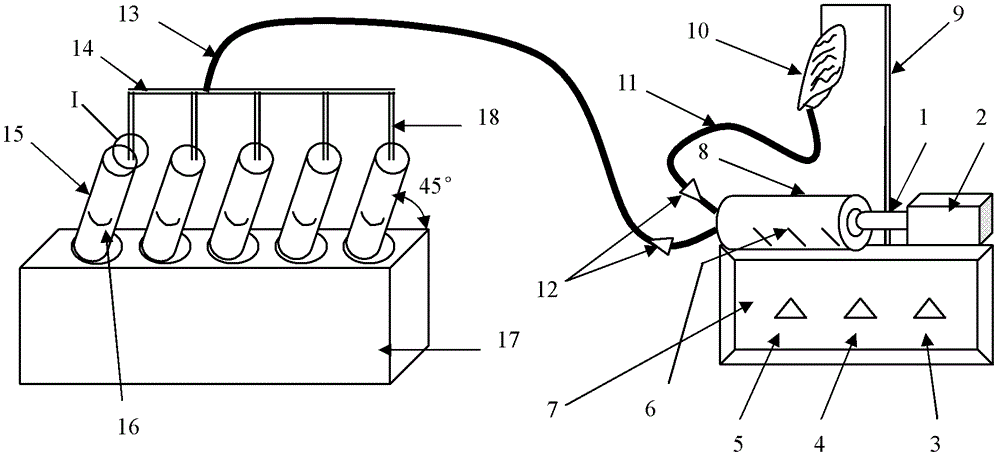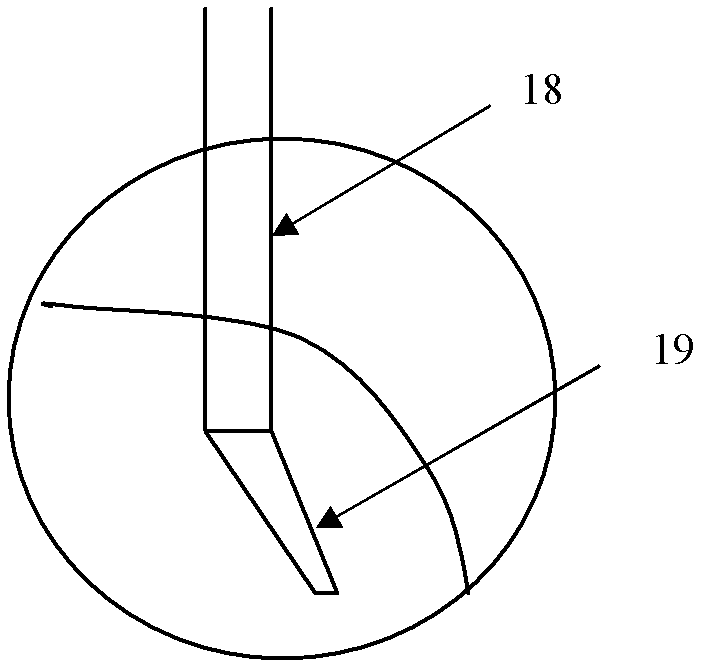Device for separating peripheral blood mononuclear cells
A technique for nuclear cells and peripheral blood, which is applied in the field of devices for the separation of peripheral blood mononuclear cells, can solve the problems of easy cell death or destruction, poor stratification effect, etc., and achieve the effect of improving the cell separation effect.
- Summary
- Abstract
- Description
- Claims
- Application Information
AI Technical Summary
Problems solved by technology
Method used
Image
Examples
Embodiment 1
[0013] As shown in Figure 1, a kind of device that is used to separate peripheral blood mononuclear cell comprises a test tube rack 17, a control box 8, is provided with the cantilever frame 9 that hangs blood bag 10 above the control box 8, and is equipped with injection pump 5 and a transparent container 8 with a scale 6, a piston and a piston rod 1 are arranged in the transparent container 8, and one end of the piston rod 1 passing through the transparent container is connected to the syringe pump 5; the other end of the transparent container is provided with two connecting conduits, One is connected to the blood bag 10 for the pumping vessel 11 , and the other is connected to the shunt tube 14 for the transfusion vessel 13 . Both connecting conduits are provided with a one-way valve 8 to ensure that the blood flow in the pumping vessel 11 can only go in and out; the blood flow in the infusion tube 13 can only go out but not in. The control box 8 has a built-in power supply...
Embodiment 2
[0020] Increase the temperature adjustment button 5 on the front panel of the control box 7, and seal the other faces of the test tube rack 17 except the top to form a five-sided box body, which contains water, so that the inserted test tube 15 is bathed in water, and around the inner wall of the box The resistance wire is set to be connected to the temperature adjustment button 5, and the voltage applied by the resistance wire can be controlled by connecting the temperature adjustment button 5 to the controller, so as to ensure that the water temperature in the tank is at a constant temperature of 20°C-25°C. Therefore, the problem of easy cell death and destruction (too high temperature) or poor stratification effect (too low temperature) of the peripheral blood mononuclear cells can be solved.
Embodiment 3
[0022] On the basis of embodiment 2, increase flow rate detection (infrared drop number sensor, place on dropper 18, be responsible for blood flow rate detection) and temperature detection (temperature sensor, be placed in the water bath box integrated with test tube rack, be responsible for blood flow rate detection) water temperature detection), a display (placed on the front panel of the control box 7), a single-chip microcomputer is added in the control box 7, and the input of the single-chip microcomputer is the signal obtained by the flow rate detection and temperature detection, and the forward and reverse switch 3, the flow control button 4 1. The temperature adjustment button 5 is related to the setting signal of artificial input. The output of the single-chip microcomputer includes real-time flow rate, temperature signal (displayed on the display), flow rate control signal (to the controller to control the forward and reverse rotation and speed of the syringe pump), t...
PUM
 Login to View More
Login to View More Abstract
Description
Claims
Application Information
 Login to View More
Login to View More - R&D Engineer
- R&D Manager
- IP Professional
- Industry Leading Data Capabilities
- Powerful AI technology
- Patent DNA Extraction
Browse by: Latest US Patents, China's latest patents, Technical Efficacy Thesaurus, Application Domain, Technology Topic, Popular Technical Reports.
© 2024 PatSnap. All rights reserved.Legal|Privacy policy|Modern Slavery Act Transparency Statement|Sitemap|About US| Contact US: help@patsnap.com









